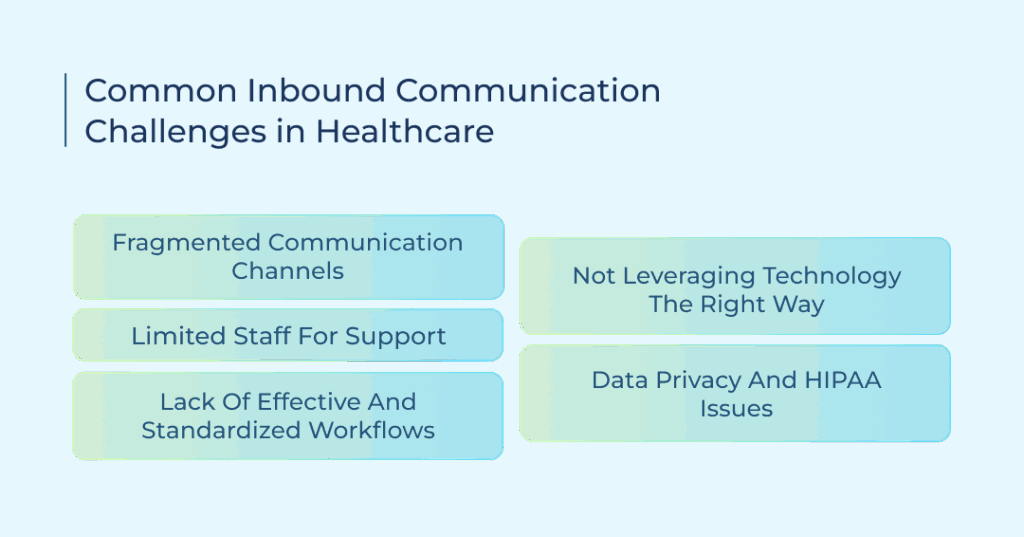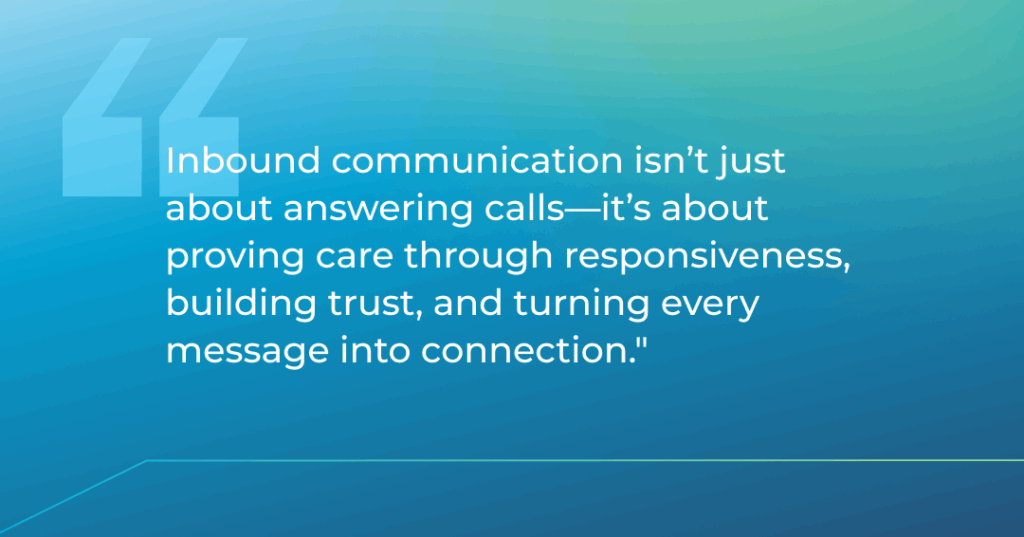Last flu season claimed the lives of more than 200 children in the United States,…

Inbound Communication in Healthcare: Why It’s Important and How to Improve It
Healthcare providers can’t afford to miss a patient’s call. That one unanswered ring could mean a delayed diagnosis, treatment pushed back, or, in the worst cases, a serious medical consequence. But the damage doesn’t stop there. Patients also lose trust when they feel ignored or left waiting, and with that, you lose their long-term loyalty.
That’s why inbound communication matters so much in healthcare. In this post, we’ll break down why it’s critical and how AI-powered inbound communication can help providers respond faster, route calls smarter, and give patients the confidence that their concerns will always be heard.
What Is Inbound Communication in Healthcare?
Inbound healthcare communication is when patients reach out to you, their provider. They might call your office to make an appointment, text questions, email billing issues, or initiate a prescription refill through the patient portal.
It’s the opposite of outbound communication, when your staff calls patients ahead of time with appointment reminders or lab reports.
Why Is Inbound Communication Important?
Healthcare providers can’t afford to see their patient communication break down. Imagine if appointments are getting missed or questions are going unanswered. Your patients will simply go elsewhere for their care.
For Patient-Centered Care
Your patients want their questions answered today, not tomorrow, and definitely not three days later. They also want to reach you in ways that are convenient to them, not you. A working mom will prefer texting during work, for example, while an older patient will prefer a phone call for reassurance. Hence, the quick, omnichannel approach works together to build trust and improve satisfaction.
Improves Operational Efficiency
A good healthcare contact center system lets your staff handle all patient messages from a single screen. Switching between different communication platforms for different channels only adds to the chaos of a busy practice. It also makes it difficult to keep track of patients, often leaving more patients frustrated than satisfied.
Reduces Care Delays and Preventable Complications
Missed or delayed responses lead to missed diagnoses or exacerbations. A patient who is sending messages of worsening symptoms needs to be quickly addressed. Without a proper inbound communication system, you’re just setting yourself up to increase readmissions and reduce health outcomes.
Improves Continuity of Care Across the Patient Journey
Your patients contact you at different phases of their journey. Inbound channels create a persistent thread across those stages. Your staff can see past inquiries and adapt their next steps. In contrast, a fragmented system breaks that continuity.
Trust and Satisfaction for Better Patient Experience
Patients judge how much you care by how quickly and clearly you respond. They don’t want to become another number in the system. It so frequently occurs that the first contact, such as scheduling an appointment, determines how a patient views your whole practice. A strong inbound communication process helps improve that perception, granting easy access for long-term loyalty.
Common Inbound Communication Challenges in Healthcare
Getting inbound communication right in healthcare might seem straightforward until you see what’s happening in most practices. Patients are put on hold, or their messages are sent to the wrong department. It’s also common to see the staff chase down information.
These minor inconveniences add up to frustrated patients and burned-out teams. Here’s what’s getting in the way.

Fragmented Communication Channels
Information gets trapped when your systems don’t connect with each other. For instance, someone calls with an urgent issue, but your staff can’t see any record of their earlier phone calls or emails.
In such a fragmented system, all channels operate in their own world. This means your staff has to piece together conversations that should be in one place from the start. This also means that patients have to repeat themselves at every point, adding to their frustration.
Limited Staff for Support
Most inbound communication still happens over the phone, which becomes challenging when call volumes spike. There might not be enough people to keep up, and additional hiring isn’t always the answer. Teams require better tools, not necessarily more workers, to ensure response times don’t get longer, and your team doesn’t feel overwhelmed trying to give everyone the same attention.
Lack of Effective and Standardized Workflows
The largest gap in healthcare contact centers is the lack of team collaboration features. Without clear processes, messages go to whoever happens to pick them up first.
What follows is that urgent issues sit in general inboxes. Routine questions get escalated to doctors who shouldn’t be dealing with them, and nobody knows who’s responsible for following up.
Patients get passed around between different people, each asking the same intake questions. It all adds up to delayed care.
Not Leveraging Technology the Right Way
The best inbound communication platforms use automated systems, chatbots, virtual consultations, and other tools that work together to improve workflow efficiency.
Many healthcare providers are slowly adopting these tools, but poor compatibility and weak integration often create more problems than solutions. Not to forget that some practices still depend on outdated systems like endless phone trees or patient portals with clunky, unfriendly interfaces.
Data Privacy and HIPAA Issues
All your messages, emails, and text messages have to be HIPAA-compliant. However, most of your typical communication devices are not made for that.
Your employees might send text messages from their personal phones, and emails might pass through standard Gmail accounts. Physicians might even exchange information with patients in unsecured chat apps. These time-saving shortcuts create compliance risks.
Moving to HIPAA-compliant platforms takes investment, and many practices struggle with the cost and setup.
Strategies to Streamline Inbound Communications as a Healthcare Provider
Most healthcare organizations make the mistake of focusing too much on their outbound communication, leaving inbound at the mercy of manual phone calls. This creates bottlenecks over time that frustrate patients and overload your staff. Here are some proven tactics that you should consider to streamline your inbound process.
Centralize all Your Inbound Channels
A centralized platform combines all touchpoints into one interface. In other words, your front desk staff can see the full conversation of a patient even if it started on the phone and continued in chat. There’s no need to jump between different systems. This prevents patients from repeating themselves and allows your staff to quickly address their concerns.
Use AI-Powered Automation for Repeating and Common Queries
Your staff can quickly burn out from answering the same questions every day, all day long. What are your visiting hours? Where are you located? Can I reschedule my appointment?
These common, repeating questions are now being handled by AI chatbots and virtual assistants. They automatically deliver quick, accurate responses without tying up the phone lines. They are also available 24/7, meaning your staff gets the time to focus on actual cases rather than watch the phone.
Use Intelligent Message and Call Routing
Questions about a lab result don’t need to go to the front desk. Having an intelligent routing system allows your patients to speak with the most suitable person/department on the first call. The system filters the calls by keywords and levels of urgency, which means your patients don’t spend their time waiting on hold getting transferred from one department to another.
Assist Your Patients With Self-Service Options
Some of your patients prefer resolving their issues themselves. Patient portals and mobile apps make this self-service possible for routine tasks. It also lightens your administrative burden.
For instance, why call the lab when you can download your test results from the app? Booking and rescheduling appointments yourself is another good example.
However, don’t see this as a replacement. Patients with complicated questions deserve attention on a phone call.
Staff Training for Effective Inbound Communication
Any new inbound system you integrate is of little use if your staff doesn’t know how to use its features properly. Hence, invest in regular training programs. Your nurses need to understand when to escalate. Your front desk should know how to quickly recognize urgent calls. Also, role-playing difficult scenarios is the best way to help your staff prepare for real situations.
Use Communication Insights and Devise Improvements
You can only start fixing something after you know it’s broken. In healthcare, that amounts to tracking different performance metrics. So, how long does it take on average to respond to messages? Which agents are struggling with certain patients? Why are patients hanging up more often when calling a specific department?
Your inbound communication relies on these KPIs. Track them regularly, and make changes based on what they say.
Why Use a Specialized Platform of Inbound Communication?
You could try managing patient messages with regular email and consumer chat apps, but healthcare has specific needs that generic tools don’t address. Privacy rules, urgent message handling, integration with medical records, and the ability to track every interaction for compliance. Here’s what a specialized inbound platform can do for you:
- Meets HIPAA requirements: These platforms encrypt messages, log who accessed what, and let you remotely wipe data from lost devices. A standard messaging app doesn’t do any of that, which puts you at legal risk.
- Everything connects in one place: When a patient emails, then calls, then texts about the same issue, your staff needs to see all three conversations together. Specialized platforms pull in communication from every channel, so nobody has to ask patients to repeat themselves.
- The benefits of smart routing: The system reads incoming messages and sends them where they need to go. Patients don’t have to be transferred again and again.
- Patients can handle routine tasks themselves: Specialized inbound platforms automate the most common tasks like appointment scheduling, prescription refills, form requests, etc.
- Medical records sync automatically: When platforms connect to your EHR, staff don’t retype information. Test results, appointment notes, and patient history flow where they’re needed without manual copying.
- Growth doesn’t break the system: The platform expands without needing a complete rebuild, while consumer apps hit limits fast as practices grow.

How TeleVox Improves Inbound Communication for Healthcare Providers
TeleVox delivers solutions that make every engagement count. We’re in the business of connecting your patients to the right resource the first time, and giving providers the insights they need to turn every interaction into something smarter and more efficient.
That starts with SMART Agent, our AI-driven virtual assistant. Like the name suggests, it’s smart enough to listen, understand, and respond across voice, SMS, and chat. It also knows when to escalate cases, so your patients always get answers without delay.
Patients can even use it to complete self-service tasks like accessing intake forms, verifying insurance, or managing billing questions without waiting on hold.
But the real magic is in how the system keeps learning. With Insights360, every inbound interaction feeds back into a cycle of improvement.
Providers see exactly where calls get stuck, how long patients wait, and where workflows can be tightened. Instead of working in the dark, you make data-driven decisions that improve your communication and patient confidence.
Ready to see all that in action? Book a demo today and discover how smarter inbound communication changes everything.



